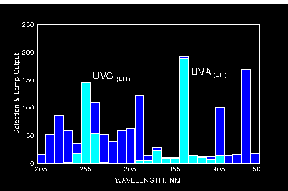Guide to UV Measurement
Optical Responsivity

Figure 1
The amplitude of response of a detector to different wavelengths is referred to as responsivity . The design of the instrument, cell type and filter results in a singular response curve. The net response curve, in percent of maximum response, is called its relative spectral responsivity . Examples of response ranges of two commercial instruments is shown in Figure 1.
Spectral responsivity is the characteristic that differentiates wide-band radiometers from narrow-band radiometers. It can be easily seen, from Figure 1, that any of these yield very different measurements when exposed to the same lamp !
The manufacturer's designations for the (selected) band of the examples illustrated in Figure 2 are:
EIT, Inc |
EIT UVC |
240-260 nm (50%) |
International Light IL |
IL 390B |
250-400 nm (10%) |
EIT, Inc. |
EIT UVA |
320-390 nm (50% |
The UVA spectral response chosen by each manufacturer is different. Users need to note the differences, understand them and pick the band that best meets their needs. Different is not wrong - it is different. Because of the bandwidth differences between manufacturers, it becomes important to not only communicate a number value (900 mJ/cm²) but also the instrument in which the data was collected. view Recommended Practices for Reporting Data

Figure 2
Further, it should be noted that, at best, the data reported for any band is a sampling of the spectral power in that band. This is illustrated in Figure 2.
All instrument manufacturers provide the responsivity data for their instruments. It should be noted if the manufacturer uses the 50% or the 10% response for the designation of bandwidth (both are illustrated in Figure 2).